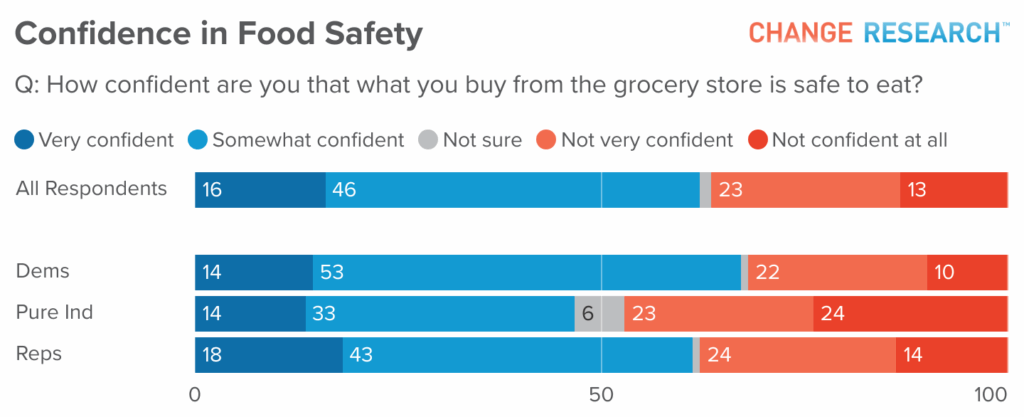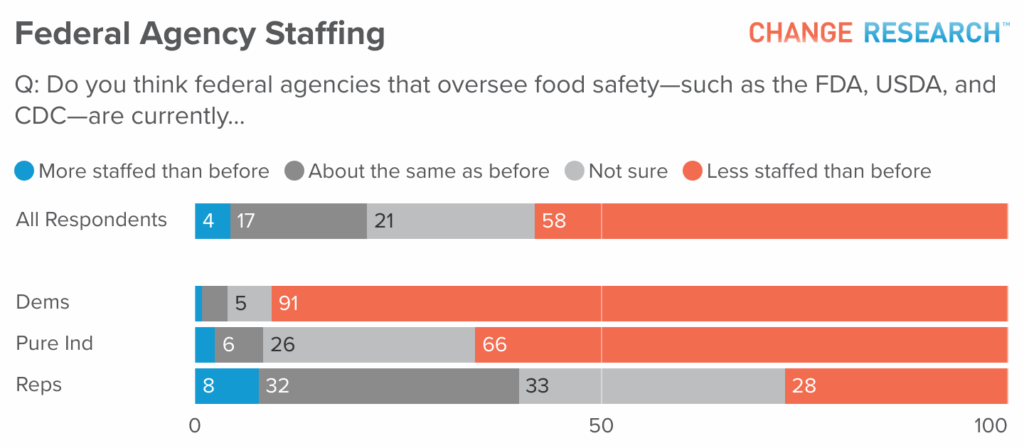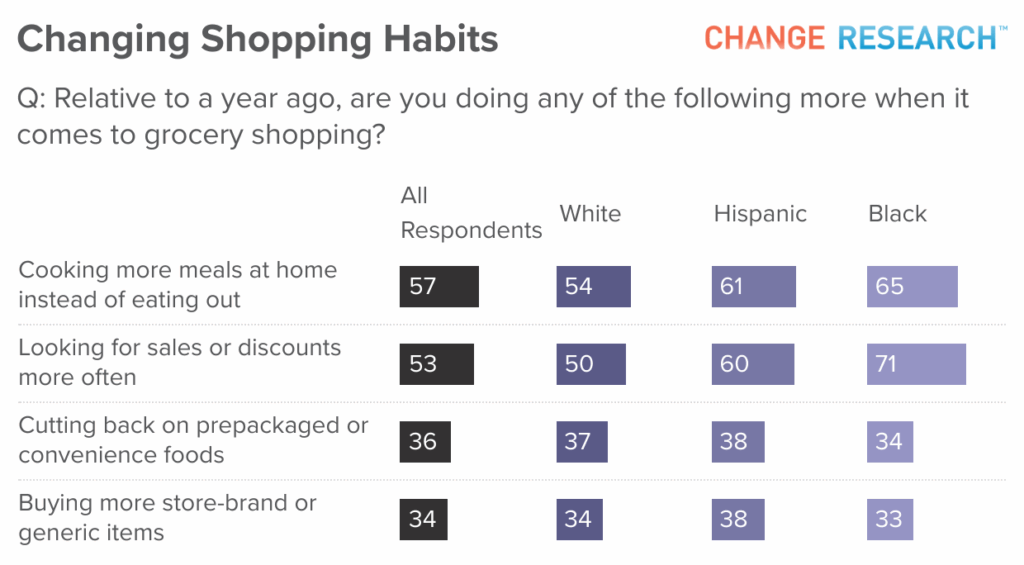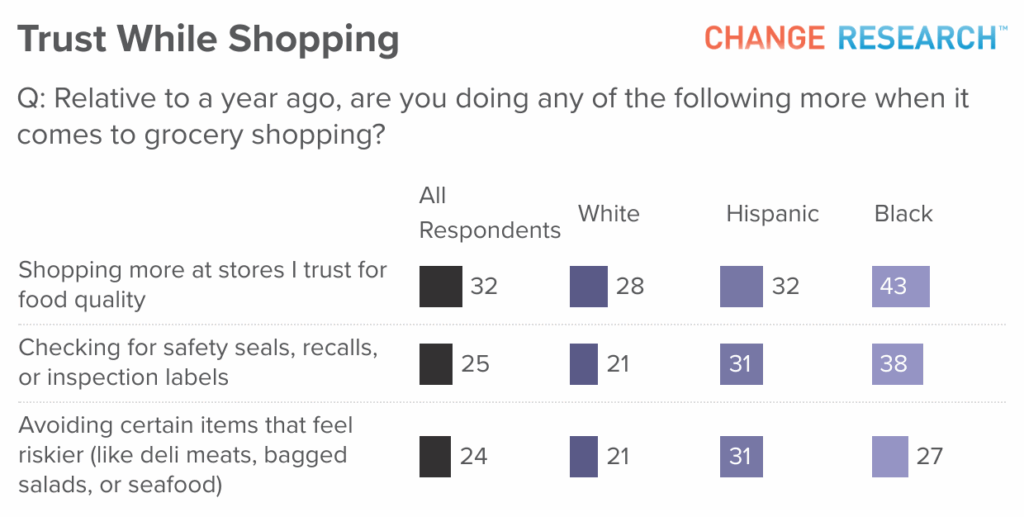A new nationwide survey by Change Research reveals a wide range of views among Americans about food safety and federal oversight capacity, even as the Food and Drug Administration faces significant workforce reductions. The poll, conducted September 5-10, 2025, interviewed 2,223 registered voters as part of Change Research’s internal Compass Poll series, which informs the Change Research Data Portal. Get access by emailing us: [email protected].
The poll was conducted five months after the restructuring of the Department of Health and Human Services, which included the elimination of 3,500 positions at the FDA.
Confidence in Food Safety Is Cautious
A majority of Americans maintain at least a moderate level of confidence in the safety of their grocery purchases, while the data reveals notable underlying concerns. Overall, 62% of respondents express confidence that what they buy from the grocery store is safe to eat, with 16% feeling “very confident” about food safety. A plurality of 46% describe themselves as “somewhat confident” about food safety.

Nearly four in ten Americans (37%) lack confidence in grocery store food safety, with 23% reporting they are “not very confident” and 13% stating they are “not confident at all.” These concerns cross demographic lines but show interesting variations. Democrats show the highest levels of trust in grocery store food safety at 67%, while only 47% of Pure Independents say they are confident in grocery food safety.
Divides Over Federal Oversight
Nearly six in ten respondents (58%) think agencies such as the FDA, USDA, and CDC are “less staffed than before,” while only 4% believe these agencies have “more staff.” This perception varies dramatically by political affiliation, with 91% of Democrats believing agencies are less staffed compared to 28% of Republicans.

That 63-point gap is one of the sharpest partisan splits in the survey. Even as documented workforce reductions have been announced publicly, Americans are interpreting the implications through very different political lenses.
Americans’ Eating Habits Are Changing
Americans indicated that they have altered their eating habits compared to a year ago. The most common change reported is eating out less often. A majority of Americans (57%) say they are cooking more meals at home. That trend is even stronger among Democrats (63%) and among respondents of color (63%).

Price also plays a central role in grocery shopping. More than half of Americans (53%) say they are looking for sales and discounts more often than a year ago. This is especially true for Democrats (68%) and Black respondents (71%). Others report cutting back on prepackaged foods (36%) or switching to store-brand and generic products (34%).
Shopping With Trust in Mind
Food safety concerns may be prompting Americans to take more active precautions in their shopping habits. About one-third of Americans (32%) say they now shop more frequently at stores they “trust for quality” than they did a year ago.

Consumers also indicated that they are checking their purchases more carefully than they did a year ago. One in four Americans (25%) say they are paying closer attention to safety seals, recall notices, or inspection labels. Another 24% report actively avoiding foods they view as higher risk, such as deli meats, bagged salads, or seafood.
Young adults are the most likely to say they are checking safety labels more than they did a year ago (31%) and avoiding perceived risky items (22%).
Self-Sufficiency on the Rise
One of the more striking findings is how many Americans are producing food themselves. A quarter of respondents (25%) say they are growing or raising some of their own food, such as herbs, vegetables, or eggs. Among pure Independents, that number climbs to 37%.
Others are shifting to foods they perceive as safer or more reliable. About 24% report buying more canned, frozen, or shelf-stable goods. That pattern is especially common among women (30%) and Democrats (30%). Meanwhile, 20% of Americans are buying more organic or “trusted brand” items, with younger adults (18-34) most likely to make this choice (28%).
Despite the rise in e-commerce elsewhere, online grocery shopping has not changed much. Only 13% of Americans say they are using online ordering more than they did a year ago.

A Picture of Adaptation Amid Uncertainty
The data presents a portrait of Americans navigating food safety and cost pressures simultaneously. Most continue to trust their food supply, but that trust is qualified. Americans are showing high levels of vigilance around food safety, adopting cost-saving strategies, and even taking on food production themselves.
Partisan divides stand out most sharply in views of government oversight. Democrats overwhelmingly perceive agencies as less staffed than they were, while Republicans are far less likely to see it that way.
The survey suggests that while confidence in food safety remains a majority view, it is not taken for granted. Americans are making adjustments both large and small, from the checkout aisle to their gardens in their own backyards. As these trends continue to develop, they may have lasting implications for both consumer behavior and the food retail industry.
